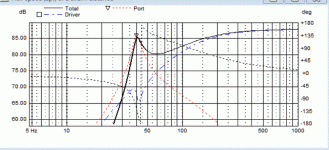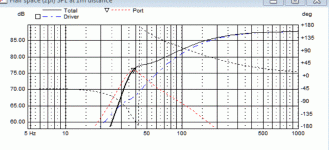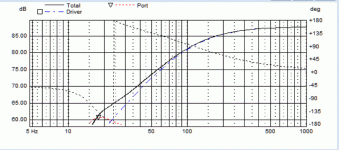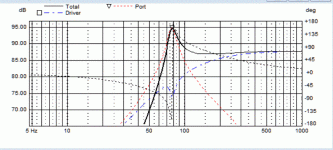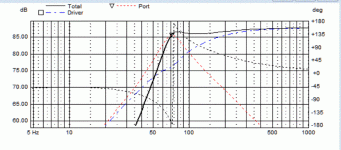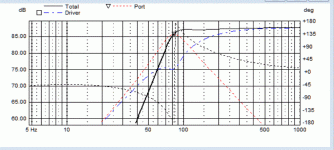I just wanted to get a sense from Tang Band driver users out there about the rated Xmax of these drivers as opposed to their real-world excursion limits.
The reason that I am asking is because have a pair of 3" Tang Bands (my first and only pair of Tang Bands so far) and I am amazed to see them go way, way beyond their excursion limit while maintaining excellent sound quality. To be more specific, I have the W3-881SI which have an Xmax of 0.5mm listed. Based on my experience with these drivers, I have to say it almost seems like a mistake in the specs; it seems more like it should be 0.5cm.
Since I was home sick all day, I decided to perform an experiment. I intentionally ran these drivers well beyond 0.5mm excursion for the entire day today. When I say well beyond, I mean to say between 3mm and 4mm with bass peaks pushing them further out, perhaps to 5mm. I normally wouldn't do this, but these things cost me peanuts and I am a curious person by nature.
The result: Nice deep bass, no ill effects. Some of you may have seen the video of me running some Leonard Cohen through these drivers. At that time I had assumed that I was pushing the drivers near their limit. Well, I can say with confidence that I pushed them beyond that excursion all day today and heard nothing but smooth sound. No warble, no slap, no crunch, nothing.
I have briefly pushed them to the point were they became less coherent, when the bass began to disrupt the fidelity of the midrange, but the excursion was simply ridiculous by that point and I did not want to see what happened next Even that little test didn't seem to have any lasting consequences. I am listening to them right now and they are working away on some smooth, low bass from a Jack Johnson track. I continue to be amazed...
Even that little test didn't seem to have any lasting consequences. I am listening to them right now and they are working away on some smooth, low bass from a Jack Johnson track. I continue to be amazed...
Anyone else have a similar experience with any of the Tang Bands (or any other drivers, for that matter?) Anyone care to offer an explanation as to how this is possible? Could it actually be a mistake in the specs?
The reason that I am asking is because have a pair of 3" Tang Bands (my first and only pair of Tang Bands so far) and I am amazed to see them go way, way beyond their excursion limit while maintaining excellent sound quality. To be more specific, I have the W3-881SI which have an Xmax of 0.5mm listed. Based on my experience with these drivers, I have to say it almost seems like a mistake in the specs; it seems more like it should be 0.5cm.
Since I was home sick all day, I decided to perform an experiment. I intentionally ran these drivers well beyond 0.5mm excursion for the entire day today. When I say well beyond, I mean to say between 3mm and 4mm with bass peaks pushing them further out, perhaps to 5mm. I normally wouldn't do this, but these things cost me peanuts and I am a curious person by nature.
The result: Nice deep bass, no ill effects. Some of you may have seen the video of me running some Leonard Cohen through these drivers. At that time I had assumed that I was pushing the drivers near their limit. Well, I can say with confidence that I pushed them beyond that excursion all day today and heard nothing but smooth sound. No warble, no slap, no crunch, nothing.
I have briefly pushed them to the point were they became less coherent, when the bass began to disrupt the fidelity of the midrange, but the excursion was simply ridiculous by that point and I did not want to see what happened next
Anyone else have a similar experience with any of the Tang Bands (or any other drivers, for that matter?) Anyone care to offer an explanation as to how this is possible? Could it actually be a mistake in the specs?
Last edited:
I think Xmax is defined as the zone where the motor has full control over the cone, in other words the place where the magnetic field has a grip on the moving parts so that other specifications are still in line. However, the driver may work fine outside that range, just a little differently than in the "comfort zone". Xmech is a related spec that states the physical excursion limits of the driver, where something whacks into something else. Between Xmax and Xmech there is a territory to explore  Surely it's different between different drivers.
Surely it's different between different drivers.
I think Xmax is defined as the zone where the motor has full control over the cone, in other words the place where the magnetic field has a grip on the moving parts so that other specifications are still in line. However, the driver may work fine outside that range, just a little differently than in the "comfort zone". Xmech is a related spec that states the physical excursion limits of the driver, where something whacks into something else. Between Xmax and Xmech there is a territory to exploreSurely it's different between different drivers.
Thanks for your response.
Yes, I have read some of the debate about Xmax/Xmech surrounding a popular brand of driver, so I am aware that these terms are open to some interpretation (or at least the application of said terms is not entirely agreed upon).
So, it only follows that each individual type of driver must be evaluated in the real world with these parameters in mind (if they are provided) but that the parameters themselves are not "absolutes". With some drivers (such as the ones in question) it is possible that there is ample room to "explore" as you so aptly stated it
Going forward I will let the price of the drivers (much more than listed specs) determine just how much I will "explore" the excursion
Last edited:
The tangband, with its tiny linear excursion, is one of the reasons why I think that all manufactures should provide an Xmech figure. As you've found out, with such a tiny amount of linear excursion (xmax) the rest of the moving parts are quite capable of operating significantly above this without causing any apparent harm to the driver. How far beyond xmax you don't know though, so it's guess work.
In this case the xmax figure would be a useful design parameter to use for say in a three way (when designing the cabinet and highpass) for keeping everything low distortion (within xmax) for normal listening levels. But you would also know (if Xmech were provided) that the driver can safely operate out to say +-3mm without any undue harm, this allowing for transient peaks perhaps in classical music, or for the times when you want to watch a movie.
As explained before normal hifi drivers tend to have say 25-50% more excursion capability, beyond their linear xmax, before you will cause any damage to the driver. This typically results in drivers having say 5mm of xmax but 7-8mm of Xmech. Designers expect this, but as the xmax figures are always reasonably high, you never tend to run into problems with exceeding xmax unless you're wanting the driver to do something it isn't intended for.
If a full range driver is designed and comes out having a tiny tiny xmax, like this tangband one, then you've got a situation where Xmech is considerably larger perhaps then xmax and in reality this area needs to be used effectively to make the most of the driver. It would be nice to know what Xmech in this case actually is, but we are not told!
In this case the xmax figure would be a useful design parameter to use for say in a three way (when designing the cabinet and highpass) for keeping everything low distortion (within xmax) for normal listening levels. But you would also know (if Xmech were provided) that the driver can safely operate out to say +-3mm without any undue harm, this allowing for transient peaks perhaps in classical music, or for the times when you want to watch a movie.
As explained before normal hifi drivers tend to have say 25-50% more excursion capability, beyond their linear xmax, before you will cause any damage to the driver. This typically results in drivers having say 5mm of xmax but 7-8mm of Xmech. Designers expect this, but as the xmax figures are always reasonably high, you never tend to run into problems with exceeding xmax unless you're wanting the driver to do something it isn't intended for.
If a full range driver is designed and comes out having a tiny tiny xmax, like this tangband one, then you've got a situation where Xmech is considerably larger perhaps then xmax and in reality this area needs to be used effectively to make the most of the driver. It would be nice to know what Xmech in this case actually is, but we are not told!
If a full range driver is designed and comes out having a tiny tiny xmax, like this tangband one, then you've got a situation where Xmech is considerably larger perhaps then xmax and in reality this area needs to be used effectively to make the most of the driver. It would be nice to know what Xmech in this case actually is, but we are not told!
I agree 100%.
If I was to judge the usefulness of this driver based on specs alone, I certainly would not have attempted to put it into a 13.3 litre cabinet tuned in the hi 40s to low 50s and run the exursion way beyond Xmax. I believe that I am making the most of this driver by doing so based on the specific goals/criteria that I had in mind.
This is not to say that the intention is to always use the drivers well beyond the specs, but it does allow me to really enhance the bass (either with EQ, "loudness" control, or a simple bass knob) while maintaining an "easy listening" SPL. They are truly "full range" in this application.
In a way I am glad I am so ignorant of these specs and of speaker design in general. I think it allows me to see that this hobby/passion/obsession/ is as much of an art as it is a science.
Last edited:
is as much of an art as it is a science
I Wouldn't go that far. Once upon a time things were more art then science, but then clever people came along and changed that. One such person is Martin King who decided to figure out exactly what was going on in funky MLTL type enclosures. No doubt this is/was a rather complicated process of comparing old simulated predictions for TLs and ported cabinets and then building and measuring many variations that combined the two to eventually come up with the design equations that will now accurately simulate how a given MLTL design will perform.
What once was more of an art has now become science.
Most of loudspeaker design is now well established science and the art aspect of it, imo, is managing to come up with visually attractive packages that manage to satisfy being extremely well designed too (and without too many compromises).
I Wouldn't go that far. Once upon a time things were more art then science, but then clever people came along and changed that. One such person is Martin King who decided to figure out exactly what was going on in funky MLTL type enclosures. No doubt this is/was a rather complicated process of comparing old simulated predictions for TLs and ported cabinets and then building and measuring many variations that combined the two to eventually come up with the design equations that will now accurately simulate how a given MLTL design will perform.
What once was more of an art has now become science.
Most of loudspeaker design is now well established science and the art aspect of it, imo, is managing to come up with visually attractive packages that manage to satisfy being extremely well designed too (and without too many compromises).
Well, what I mean is that the "pure science" approach would have guided me away from the design that I ended up with (or completely dismissed it). If I had been "educated" about the science behind this, I might not have thrown caution to the wind and taken a chance with these drivers in this type of box. I had a vision in mind with respect to the physical dimensions and the practical usage of the loudspeakers and I had a pair of drivers and some simple tools. In a matter of a few very enjoyable hours, I successfully realized that vision, and it seems to me that the process was as much art as it was science. Perhaps more luck than anything else. If the drivers had blown the first time I exceeded Xmax, I would certainly be singing a different tune
I do not know enough about Martin King et. al. to be any sort of judge of their work, except that I am a direct beneficiary of such work since building my Planet-10 microTowers. I followed the plans as precisely as possible, used much higher quality materials, cut no corners, etc. This was way more science than art (except perhaps in my finishing work) and the speakers sound incredible. Considerably better than my own creation, to be sure. Yet, my little "nanoTowers" are very pleasing speakers and are much more than the sum of their parts (IMO).
So, the question remains; how much can we really say about the application of a driver based on a parameter such as Xmax? The scientific approach would seem to say "well, if we plug these numbers into our software, we see that we will get such and such excursion at such and such frequency and power input, therefore..." whereas the artistic approach seems to say "I don't care, let's just build it and see what happens".
The second approach is far more appealing with inexpensive components.
I have some Tangband 3" drivers from the Logitech Z5500 system
Built surround sound speakers out of them (4 per enclosure) and was surprised how much they could put out running full range. Considering the people that buy that system and blast it--I figure TB just under rated the Xmax or has a huge Xmech to keep the speakers intact.
Xmech would be a great spec to know--some drivers when used as subwoofers will hit Xmax at 90 watts but Xmech is at 290 watts (LAB12?) when tuned to infrasonic frequencies. To match an amplifier, I'd use a 200 watt amp instead of a 100 watt to gain the headroom although it would generally not be driven that hard.
I can understand why manufacturers don't provide Xmech--because some folks would design their enclosure to run on the edge of destruction and increase warranty issues. As a manufacturer, the Xmech is a safety so they won't be "at fault" when a person makes a box with air leaks.
Maybe Tangband does what Cerwin Vega does (or used to), under rate Xmax with a large Xmech? My Cerwin 15's (pro woofers) move a lot farther than their 4.5mm Xmax would indicate although the accordion surround will tend to limit stroke at very high levels.
Built surround sound speakers out of them (4 per enclosure) and was surprised how much they could put out running full range. Considering the people that buy that system and blast it--I figure TB just under rated the Xmax or has a huge Xmech to keep the speakers intact.
Xmech would be a great spec to know--some drivers when used as subwoofers will hit Xmax at 90 watts but Xmech is at 290 watts (LAB12?) when tuned to infrasonic frequencies. To match an amplifier, I'd use a 200 watt amp instead of a 100 watt to gain the headroom although it would generally not be driven that hard.
I can understand why manufacturers don't provide Xmech--because some folks would design their enclosure to run on the edge of destruction and increase warranty issues. As a manufacturer, the Xmech is a safety so they won't be "at fault" when a person makes a box with air leaks.
Maybe Tangband does what Cerwin Vega does (or used to), under rate Xmax with a large Xmech? My Cerwin 15's (pro woofers) move a lot farther than their 4.5mm Xmax would indicate although the accordion surround will tend to limit stroke at very high levels.
Hi,,
Numbers hardly ever tell the real story, unless you understand them.
Here we have a underhung voicecoil, but by only 1mm, probably
around 7mm long in a 8mm gap. Xmech is generally useless.
Given the above and the resulting BL curve versus excursion, its
fair to say excursion causes graceful bass overload, the more
excursion the more distortion up to the unusable point.
What you can say about the above is it probably works well up
to about 50% of the coil in the gap, giving +/- 4mm or so.
Halving BL changes all the small signal parameters, and a design
to work well pushed, needs to take this into account, most don't.
rgds, sreten.
Numbers hardly ever tell the real story, unless you understand them.
Here we have a underhung voicecoil, but by only 1mm, probably
around 7mm long in a 8mm gap. Xmech is generally useless.
Given the above and the resulting BL curve versus excursion, its
fair to say excursion causes graceful bass overload, the more
excursion the more distortion up to the unusable point.
What you can say about the above is it probably works well up
to about 50% of the coil in the gap, giving +/- 4mm or so.
Halving BL changes all the small signal parameters, and a design
to work well pushed, needs to take this into account, most don't.
rgds, sreten.
Well, what I mean is that the "pure science" approach would have guided me away from the design that I ended up with (or completely dismissed it). If I had been "educated" about the science behind this, I might not have thrown caution to the wind and taken a chance with these drivers in this type of box.
Indeed I assumed that's what you were meaning before, but even though something works, I wouldn't assume it's the best just because it happened to be pleasing the first time round.
Your vision created the style of the box and then your enthusiasm ended up creating the loudspeaker that you now have today. Nothing can be said that will take away from that accomplishment, however, the cabinet could also be easily incorporated extremely successfully into a more 'optimum' alignment for this driver.
As you've built such a large cabinet it does indeed offer room for experimentation if you so desire. I cannot tell you that other alignments will sound better in your room, only that the theory shows a strong preference for a different arrangement then you've currently got.
If the long narrow aspect of the cabinet happens to lower the tuning frequency by a certain % due to some MLTL loading, then this, in my opinion, necessitates some impedance measurements to make sure that your simulations match the real world.
If I were in your position I would start by measuring the impedance to check where the tuning frequency lies. After having done so I'd want to experiment with a higher port tuning (measured tuning) of around 80hz and then heavily stuff the boxes and see how that sounds. Theory predicts it should sound better, although it might not have quite the same extension as you've got now.
The next thing I'd want to try, is again, heavily stuffing the enclosure, but filling the bottom of it with sand so that the net internal volume was significantly less ~4-5 litres and again going for a real measured tuning of around 80hz. Filling the bottom of the cabinet with sand should also greatly aid in the stability of such a tall/narrow cabinet.
I would do this because I would be curious, first of all to know how the simulated predictions match up with the real world and then to which one I prefer with regards to sound quality. This should theoretically educate me about the limitations of my design software, how perhaps a very tall and thin enclosure impacts on the tuning frequency of a ported cabinet with the port close to the bottom and then towards what type of alignments I prefer.
Of course if the cabinet showed significant TL loading, I'd want to try plugging up the port at the bottom and putting the port mid way up the cabinet to see if it had any change on the tuning frequency.
So, the question remains; how much can we really say about the application of a driver based on a parameter such as Xmax? The scientific approach would seem to say "well, if we plug these numbers into our software, we see that we will get such and such excursion at such and such frequency and power input, therefore..." whereas the artistic approach seems to say "I don't care, let's just build it and see what happens".
The second approach is far more appealing with inexpensive components.
Regardless of how expensive the components are you still have to build a box and this requires some considerable effort. This is the thing I want to minimise the chances of getting wrong.
We can say a great deal towards the application of a driver based on its Xmax, but more importantly we can quite simply state that it will sound worse when operating at greater physical excursion. All drivers become less linear as excursion increases, even if xmax isn't exceeded. The rate at which they lose linearity shoots up however when you exceed rated xmax.
This isn't your point though and when taken as a whole it basically states.
how much can we really say about the application of a driver based on it's parameters
Well without them we can say nothing about it, because we now know nothing. With them though we can start to say a great deal.
I have no arguments against a built it and find out approach but the 'finding out' is the important bit. If you did indeed know nothing about a driver, then putting it into an application and measuring how it behaves would be a good way of finding out a lot about it. Simply building and then doing nothing except listening wouldn't tell you a whole lot. If it sounded crap you'd need to measure to figure out why, otherwise you'd be prone to repeating the same thing again. Just because something initially sounds pleasing doesn't mean you should stop there, that is unless you're perfectly happy with what you've got. But experience tells me that if there is room for experimentation at the possibility of improving things, at some point, I am going to want to try.

Hi,,
Numbers hardly ever tell the real story, unless you understand them.
Here we have a underhung voicecoil, but by only 1mm, probably
around 7mm long in a 8mm gap. Xmech is generally useless.
Given the above and the resulting BL curve versus excursion, its
fair to say excursion causes graceful bass overload, the more
excursion the more distortion up to the unusable point.
What you can say about the above is it probably works well up
to about 50% of the coil in the gap, giving +/- 4mm or so.
Halving BL changes all the small signal parameters, and a design
to work well pushed, needs to take this into account, most don't.
rgds, sreten.
Perhaps what I have created here, then, is a situation in which the resulting low bass extension, as distorted as it might be (I cannot hear it) is still a far better compromise (for me) than no low bass extension at all.
In other words, it has been suggested that a higher-tuned cabinet would be more appropriate (80hz, for example). I understand that such a tuning (due to being closer to the Fs of 106hz) would result in a "better sounding speaker" because the low end response would be flatter, the excursion would be lower, and the group delay would be lower. This may be true, but then this speaker would also not reach down below, say 60hz, very well, either.
With a driver such as this, which seems to so gracefully deal with excessive excursion (ie. well beyond Xmax) and with such a relatively high Qts (more gradual rolloff), the choice might also be made to tune much lower, gaining considerable extension in the low end, while realizing that group delay and response flatness will suffer.
When it comes to group delay, my understanding is that it is basically not audible until somewhere around 1000hz and up.
When it comes to lack of low end response flatness, some fidelity is lost certainly but the very full low end at least makes the speaker sound truly "full range".
So yes, it is not ideal, and yes certain things are compromised, but I specifically chose to have my wavy low end response extend solidly into the high 40s to low 50s (with usable bass into the 30s) rather than have them be "perfect" to 80hz and then plummet...
To my ears, a single driver speaker (with no sub(s) or "helper woofers") that is imperfect but at least represents nearly the entire spectrum will always sound better than one that is "ruler flat" and falls off sharply after 80hz. This is perhaps personal preference, and the caveat in this specific example is dangerous excursion at anything beyond "easy listening" SPL. As luck would have it, that is exactly what the intended purpose of these speakers is.
5th,
I cannot modify the speakers at this point. I fully committed (glued them tight) on build day since I was so happy with the way they sound. This weekend I will sand/finish them. However, I do think I will by at least one more set of these drivers. Perhaps then I will try what you have recommended. I am curious but skeptical whether an 80hz tuning would please me in a sub-less setup...
For clarity, I should probably state that my definition of "easy listening SPL" is about 65-70dB (with peaks up to about 72dB) at the listening position. In this case, my listening position is about 11'-12' from each speaker. At this position, at 65-70dB SPL, the low bass is very smooth and rich. Cone excursion is somewhere between 2-3mm (depending on the track playing, of course). Watching the SPL meter, it is often obvious that it is in fact the bass line that is pushing the higher SPL peaks (again, depending on the track).
An example; U2's "Exit" from "The Joshua Tree". Plenty of heavy, low bass. Nothing is missing. At times the bass is the only thing playing, easily pushing 72dB consistently with no signs of stress. It sounds like it should.
An example; U2's "Exit" from "The Joshua Tree". Plenty of heavy, low bass. Nothing is missing. At times the bass is the only thing playing, easily pushing 72dB consistently with no signs of stress. It sounds like it should.
Last edited:
cogitech,
What size enclosure are you using ? Dimensions would be cool . I just received a pair of these today,psyched to give them a try.
http://www.diyaudio.com/forums/full-range/200912-nanotower-tang-band-w3-881si.html
All the details of my build are there.
Based on much of the feedback I have received, I find it hard to recommend that you build them, but based on my specific criteria and my listening experience with them, I can recommend them very much.
If you need to crank them and/or plan to use a sub with them, please do not follow my plan
Last edited:
Thanks for the info,your experiment sounds cool to me. The little TBs seem to be forgiving,I will have to play around with them.
I just realized you were the one that became interested in these when I posted a link to these on that other thread. Thanks for going first. Man,you work fast.
I just realized you were the one that became interested in these when I posted a link to these on that other thread. Thanks for going first. Man,you work fast.
It's a shame that we don't have partexpress in the UK because I'd love to have loads of the bargain basement buyout deals that you have just so I could get to experiment more often.
In the case of these drivers I am not convinced that you are actually hearing full low bass fundamentals, rather then the harmonics, either present as part of the original signal, or generated as distortion from the driver. There's a reason why good low bass is hard to do and a full range 3" driver with 0.5mm of xmax isn't going to it.
Group delay will actually increase with a higher port tuning. It is the ports interaction and contribution that gives the increase in group delay, so the higher you put it, the higher it's contribution comes into play.
In your case because of the large peak put it at the tuning frequency you get a dramatic increase in group delay that is sharp and narrow in nature. This is why heavily stuffing helps a lot. In this instance the contribution of the port is far too strong and heavily stuffing everything diminishes its effect whilst keeping the tuning frequency roughly the same. It smooths out the frequency response quite admirably and as the peak in the frequency response is significantly reduced, so is the peak in the group delay. Normally one doesn't want to heavily stuff a ported box because it limits how effective the port can be, in this case you are actually wanting to exploit this to give you a more even result.
Originally you had something that looked a lot like this.

Which is far from ideal for a number of reasons. The first is that you've got the spike at the ports tuning frequency, the second is that you're losing output from the driver as high as around 200hz.
Heavily stuff and we end up with something like this.
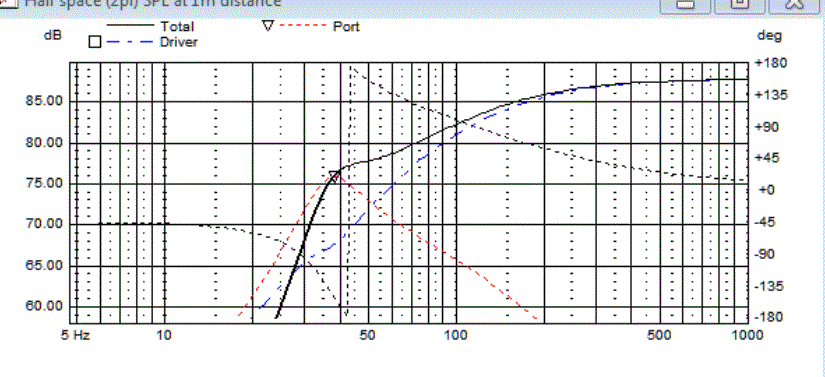
As you can see the ports output has been tamed and as a result we've lost that ugly peak at the tuning frequency. The upper response however remains unchanged.
Lets lower the tuning frequency down lower to 20hz and now see what we get.

Basically very little contribution from the port and as P10 mentioned in a previous thread, the lower you tune, the closer the response ends up looking like a sealed box. The ports output is supposed to augment the roll off of the driver, filling in where it starts to roll off and thus helpfully extend it's lower range output. In a maximally flat alignment the ports contribution compensates exactly for the loss of the driver (in this case starting at around 200hz) and fill it in. This is why P10 said he wasn't surprised that when you put the port tuning back (increased it) in the castles that you preferred the sound. The lower port tuning wasn't filling in the upper bass lower midrange as well as the higher tuning did so it left the area slightly thin. This is what's happening big style in this case as the low port tuning of around 40hz and possibly lower if we've got TL action going on, isn't compensating for the drivers intrinsic loss around 200hz.
If you raise up the tuning frequency to around 80hz in your 13l cabinet, but go un-stuffed you end up with this.

Which I am sure you will agree is in no way desirable, however you will notice that the ports contribution has filled in the area below 200hz quite well.
Stuff it to 100% fill and we end up with this.
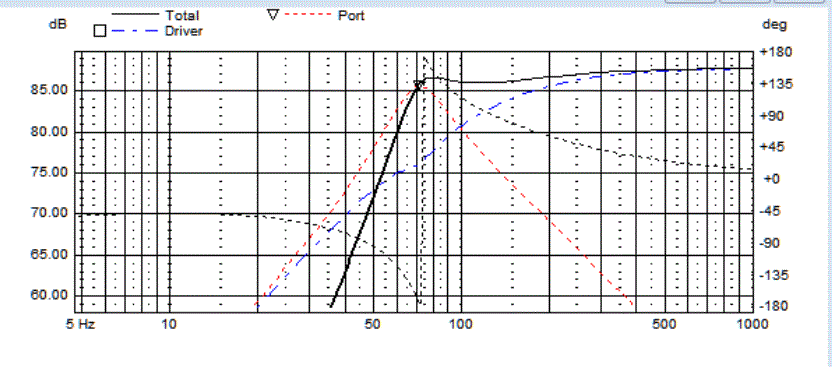
The ports output is now under control but we've lost a little bit of the supporting output in the higher frequencies, this comes as no surprise, but its a lot better then with the 40hz tuning.
If you now shrink the box down to 4 litres and keep a high tuning frequency with a fully stuffed box then we end up with this.
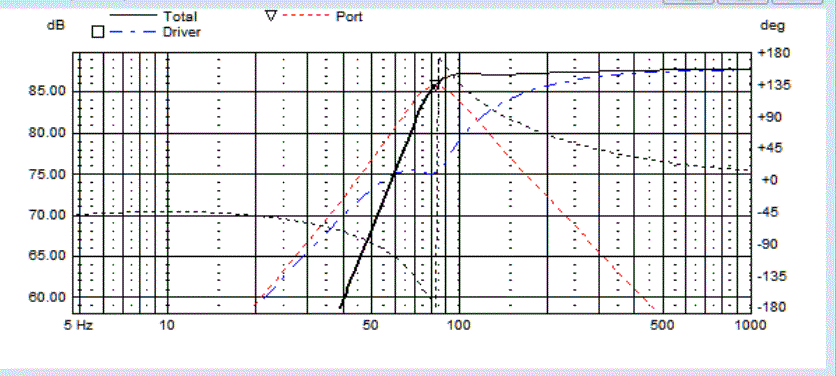
This maximises the ports contribution in an attempt at keeping the lower midrange and upper bass as smooth as possible and succeeds rather well.
It bares mentioning here that the bass output of the 4litre vs the 13 litre cabinet is almost identical with the higher tuning frequencies, so you're unlikely to notice much of a difference there, but the midrange is handled better.
If you look at the heavily stuffed option of your 40hz tuning you will notice that the bass output is actually a lot worse then the higher tuned heavily stuffed cabinets. Now in your case you've not stuffed to 100%, but still you're lacking a considerable amount of output in the 80-200hz region that is critical for enjoyment and far more critical then any extension down to 40hz - which you seemed to prove by your results from swapping back to the higher tuning frequency of the castles. As far as I recall you've had to apply some EQ boost around 80hz to keep things sounding right, which is no surprise all things considered.
In the case of these drivers I am not convinced that you are actually hearing full low bass fundamentals, rather then the harmonics, either present as part of the original signal, or generated as distortion from the driver. There's a reason why good low bass is hard to do and a full range 3" driver with 0.5mm of xmax isn't going to it.
Group delay will actually increase with a higher port tuning. It is the ports interaction and contribution that gives the increase in group delay, so the higher you put it, the higher it's contribution comes into play.
In your case because of the large peak put it at the tuning frequency you get a dramatic increase in group delay that is sharp and narrow in nature. This is why heavily stuffing helps a lot. In this instance the contribution of the port is far too strong and heavily stuffing everything diminishes its effect whilst keeping the tuning frequency roughly the same. It smooths out the frequency response quite admirably and as the peak in the frequency response is significantly reduced, so is the peak in the group delay. Normally one doesn't want to heavily stuff a ported box because it limits how effective the port can be, in this case you are actually wanting to exploit this to give you a more even result.
Originally you had something that looked a lot like this.
Which is far from ideal for a number of reasons. The first is that you've got the spike at the ports tuning frequency, the second is that you're losing output from the driver as high as around 200hz.
Heavily stuff and we end up with something like this.
As you can see the ports output has been tamed and as a result we've lost that ugly peak at the tuning frequency. The upper response however remains unchanged.
Lets lower the tuning frequency down lower to 20hz and now see what we get.
Basically very little contribution from the port and as P10 mentioned in a previous thread, the lower you tune, the closer the response ends up looking like a sealed box. The ports output is supposed to augment the roll off of the driver, filling in where it starts to roll off and thus helpfully extend it's lower range output. In a maximally flat alignment the ports contribution compensates exactly for the loss of the driver (in this case starting at around 200hz) and fill it in. This is why P10 said he wasn't surprised that when you put the port tuning back (increased it) in the castles that you preferred the sound. The lower port tuning wasn't filling in the upper bass lower midrange as well as the higher tuning did so it left the area slightly thin. This is what's happening big style in this case as the low port tuning of around 40hz and possibly lower if we've got TL action going on, isn't compensating for the drivers intrinsic loss around 200hz.
If you raise up the tuning frequency to around 80hz in your 13l cabinet, but go un-stuffed you end up with this.
Which I am sure you will agree is in no way desirable, however you will notice that the ports contribution has filled in the area below 200hz quite well.
Stuff it to 100% fill and we end up with this.
The ports output is now under control but we've lost a little bit of the supporting output in the higher frequencies, this comes as no surprise, but its a lot better then with the 40hz tuning.
If you now shrink the box down to 4 litres and keep a high tuning frequency with a fully stuffed box then we end up with this.
This maximises the ports contribution in an attempt at keeping the lower midrange and upper bass as smooth as possible and succeeds rather well.
It bares mentioning here that the bass output of the 4litre vs the 13 litre cabinet is almost identical with the higher tuning frequencies, so you're unlikely to notice much of a difference there, but the midrange is handled better.
If you look at the heavily stuffed option of your 40hz tuning you will notice that the bass output is actually a lot worse then the higher tuned heavily stuffed cabinets. Now in your case you've not stuffed to 100%, but still you're lacking a considerable amount of output in the 80-200hz region that is critical for enjoyment and far more critical then any extension down to 40hz - which you seemed to prove by your results from swapping back to the higher tuning frequency of the castles. As far as I recall you've had to apply some EQ boost around 80hz to keep things sounding right, which is no surprise all things considered.
Attachments
- Status
- This old topic is closed. If you want to reopen this topic, contact a moderator using the "Report Post" button.
- Home
- Loudspeakers
- Full Range
- Tang Band Xmax
